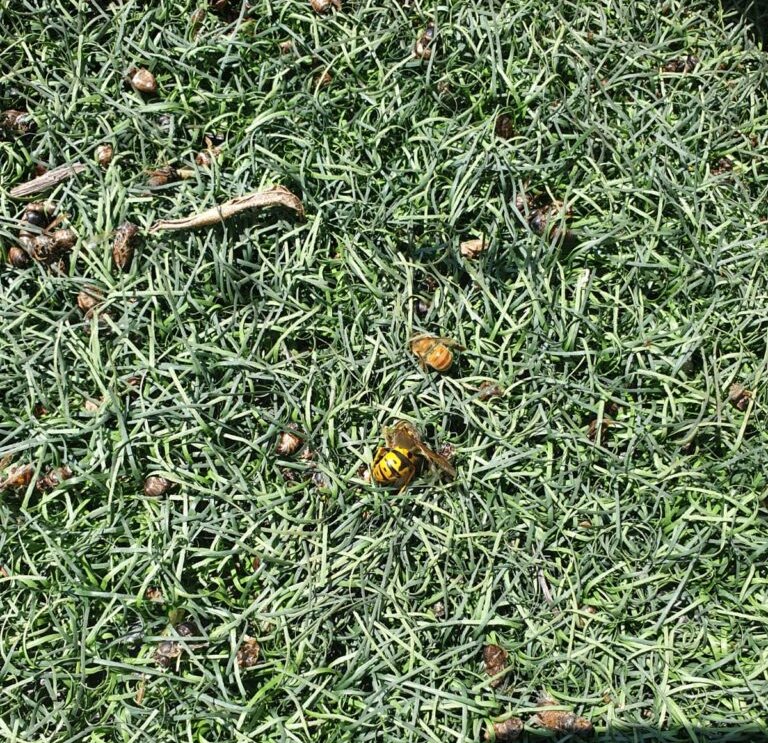- April 17, 2023
- Posted by: honeybeesadmin
- Category: Media


Honeybees are well known for their defense when it comes to protecting their colonies and food stockpile. Defense can take many forms from physical, chemical, or behavioral (Gruter, Jongepier, Foitzik, 2017), and honeybees utilize several strategies to defend their colonies and their geographical space against predatory pressures such as the one from hornets (Seeley, Seeley, Akratanakul, 1982; Breed, Guzman-Novoa, & Hunt, 2004; Barrachi, Cusseau, Pradella, Turillazzi, 2010). Hornets hunt for insects to feed offspring that demand a continuous source of fresh prey, which can be provided in abundance by the resources in a honeybee colony (Monceau, Maher, Bonnard, Thiery, 2017). Hornets have larger bodies than the victim’s, and they have strong mandibles which they use for crushing, dismembering, and masticating their prey. In addition, they have a venomous sting and are armored to avoid stings themselves (Koeniger et al. 1996). Hornets have no difficulty attacking honeybees whether on the ground, near the entrance of the hive, or hawking the bees from the air as long as their goal is achieved – debilitation or death of the colony (Barrachi et al. 2010).
On the other hand, honeybees utilize different strategies to protect the colony. The most common defense strategy observed is a small entrance that will not allow large-body predators to enter when bees are protected behind enclosed walls, and guards are in place to monitor the entrance. Bees may also use a synchronized body shaking or wave-like movement as a warning sign when hornets approach (Koeniger et al. 1996) or they may produce hissing or buzzing sounds in response to predators. An excellent strategy employed by many bee species is killing hornets by overheating and suffocating individual attackers in a ball of bees (Seeley et al. 1982; Koeniger et al. 1996; Ken et al. 2005). Hornets, to have a successful attack, may chemically mark the hive with pheromones, and after recruiting, through unknown means, up to 50 hornets, they attack the bees by grabbing and killing them one after another (Matsuura, Sakagami, 1973). The slaughter-like behavior of the hornets allows them, within a few hours, to kill thousands of bees, occupy the hive, and plunder the cells with the brood and food. To deal with this type of attack, honeybees collect and smear plant-based materials around the hive’s entrance, which will interfere with pheromones deposited by hornet scouts (Fujiwara, Sasaki, Washitani, 2016, 2018).
References:
Barrachi, D., Cusseau, G., Pradella, D., Turillazzi, S. (2010). Defence reactions of Apis mellifera ligustica against attacks from the European hornet Vespa crabro. Ethol Ecol Evol, 22, 281–294. https://doi.org/10. 1080/03949370.2010.502323
Breed, M. D., Guzman-Novoa, E., Hunt, G. J. (2004). Defensive behavior of honey bees: organization, genetics, and comparisons with other bees. Annu Rev Entomol, 49, 271–298. https://doi.org/10.1146/annurev. ento.49.061802.123155 PMID: 14651465
Fujiwara, A., Sasaki, M., Washitani, I. (2016). A scientific note on hive entrance smearing in Japanese Apis cerana induced by pre-mass attack scouting by the Asian giant hornet Vespa mandarinia. Apidologie. 47, 789–791. https://doi.org/10.1007/s13592-016-0432-z
Fujiwara, A., Sasaki, M., Washitani, I. (2018). First report on the emergency dance of Apis cerana japonica, which induces odorous plant material collection in response to Vespa mandarinia japonica scouting. Entomol Sci, 21, 93–96. https://doi.org/10.1111/ens.12285
Gruter, C., Jongepier, E., Foitzik, S. (2018). Insect societies fight back: the evolution of defensive traits against social parasites. Philos Trans R Soc Lond B Biol Sci, 373, 20170200. https://doi.org/10.1098/ rstb.2017.0200 PMID: 29866913
Ken, T., Hepburn, H. R., Radloff, S. E., Yusheng, Y., Yiqiu, L., Danyin, Z., et al. (2005). Heat-balling wasps by honeybees. Naturwissenschaften, 92, 492–495. https://doi.org/10.1007/s00114-005-0026-5 PMID: 16151794
Koeniger, N., Koeniger, G., Gries, M., Tingek, S., Kelitu, A. (1996). Observations on colony defense of Apis nuluensis and predatory behavior of the hornet, Vespa multimaculata. Apidologie, 27, 341–352. https://doi.org/10.1051/apido:19960502
Monceau. K., Maher, N., Bonnard, O., Thiery, D. (2013). Predation pressure dynamics study of the recently introduced honeybee killer Vespa velutina: learning from the enemy. Apidologie, 44, 209–221. https:// doi.org/10.1007/s13592-012-0172-7
Matsuura, M., Sakagami, S. F. (1973). A bionomic sketch of the giant hornet, Vespa mandarinia, a serious pest for Japanese apiculture. J Fac Sci Hokkaido Univ Ser VI Zool, 19, 125–162.
Seeley, T. D., Seeley, R. H., Akratanakul, P. (1982). Defense strategies of the honeybees of Thailand. Ecol Monogr, 52, 43–63. https://doi.org/10.2307/2937344
